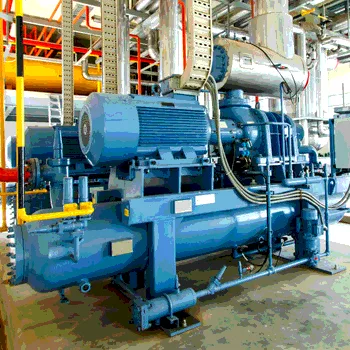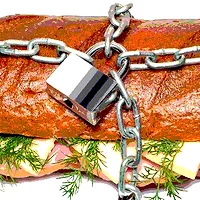Ammonia Refrigeration Systems and Chlorine Sanitation Systems Deserve Close Scrutiny

Food defense planning often concentrates solely on protecting food products from intentional contamination. In the evolving world of adversary and defender, however, it is also necessary to consider the systems that are essential to the food production and processing cycles—like ammonia refrigeration systems and chlorine sanitation systems—that are ubiquitous in food processing plants.
A thinking adversary is always trying to gain advantage, to out-think the defender to find a way to leverage for effect. Food system adversaries would seek to kill and injure people in the process sowing doubt and fear. They would want consumers to believe that the government can’t protect them because they (the adversaries) are so deeply embedded in our culture that they can’t be stopped from causing more death and destruction. That is practically the definition of terror.
Given a robust food defense plan and a system that successfully protects products, are there other options available to the adversary? One possible alternative target is the system itself. In other words, if the adversary can’t attack the actual food product, can the food production or processing plant itself be attacked in a way to achieve the goal of terror and destruction? The answer is yes.
Some government and military officials, for example, consider ammonia to be a likely first-choice terrorist weapon. As controls on the ammonia supply have tightened, industrial refrigeration systems remain the most likely source of ammonia gas. And food processing plants, needless to say, are full of industrial refrigeration systems.
Here is where I have to be careful in what I say. I have published previous articles cautioning the need for increased security around ammonia and chlorine tanks and systems. Now, I believe an update is necessary because of a confluence of apparently disparate facts regarding events outside the United States and Europe.
Since they are exceedingly busy, food processing plant, food safety, and food defense managers likely don’t carefully monitor events outside their own areas of responsibilities. So here are several points that need to be put into context and understood in the context of food defense, should adversaries turn toward systems:
• Hezbollah is a terrorist group at war with Israel. In 2017, Israel successfully targeted and killed three high-ranking members of the organization. Hezbollah is financed by Iran and their proxies in places including Iraq, Bahrain, and Yemen. They also have been heavily involved in the Syrian Civil War. After the three Hezbollah leaders were killed, Hezbollah leader Hassan Nasrallah pointed out the organization’s precision missile capability and ability to target an Israeli ammonia transfer tank in Haifa Bay. He boasted that “…even if the ammonia tank is transferred to another site, Hezbollah will hit it,”[1] noting their capability to hit the actual ship carrying the ammonia.
• The important thing is not the missile threat. The important thing is that a known terrorist organization has openly threatened to target ammonia tanks. Terrorist organizations, by the way, have been known to emulate the techniques of others and also to cooperate, even with groups outsiders might consider their competitors or even enemies. The old adage of “the enemy of my enemy is my friend” is very real in the Middle East. The most important implication here is that ammonia tanks are seen as potential terrorist targets.
• In January 2017, ISIS announced the formation of a new drone warfare unit designed to inflict “a new source of horror for the apostates.”[2] Drones have dropped PVC pipes filled with high explosives and 40-mm mortar rounds with a surprising degree of precision. The most important implications here are the degree of precision, and ISIS’ access to drones that can be used to inflict death and injury on military and civilian populations. Again, it is important to note that terrorist organizations emulate each other.
• In a Washington Post article entitled Use of Weaponized Drones by ISIS Spurs Terrorism Fears,[3] author Joby Warrick noted, “The threat to troops is serious enough to prompt U.S. and Iraqi commanders to issue warnings to soldiers near the front lines. But a far bigger worry, U.S. officials say, is the potential for future attacks against civilians. Islamist militants have long discussed the possibility of using drones as remote-controlled missiles that can deliver explosives or even unconventional weapons such as deadly nerve agents. In recent weeks, the notion of terrorist drones has moved a step closer to reality, terrorism experts say.” Further, “…a Pentagon official acknowledged that coalition troops had been forced to take countermeasures against drones—steps that include early-detection systems and electronic jamming—while also stepping up the search for factories and staging areas where the aircraft are being readied for use on the battlefield.” Many countries, including those hostile to the U.S., manufacture military grade drones. The implication here is that although the military is able to deal with the threat because they have the tools and techniques to do so, civilian populations and businesses do not.
• Nick Waters, an ex-British Army officer and open-source intelligence analyst, has authored a detailed, privately produced report on ISIS’ ability to modify drones and use them for targeted strikes with explosives. The report, entitled, Death From Above: The Drone Bombs of the Caliphate,[4] is worth a read. The implication here is that ISIS has the engineering capability and access to equipment to successfully weaponize civilian-grade drones—and once again, it is important to remember terrorist groups cross-fertilize each other. ISIS may be in retreat, but that doesn’t mean the danger is gone.
Adversaries are human, and they think like humans. They vary in intelligence and cleverness, but more importantly, they vary in how hard they will work to accomplish their goal—in this case, contamination of a food product. Adversaries often choose their targets simply because they are easily accessible. Think about it—many car thefts result because people leave keys in the car. Many home break-ins occur because victims leave doors unlocked. Adversaries are no different; they want to avoid detection and avoid delays in gaining access. A well-designed food defense system discourages the adversary, hopefully so much that they go elsewhere and become someone else’s problem.
So what is the bottom line? First, this all connects. A terrorist organization has the means and capability to utilize drones to target military and civilian populations, and terrorist organizations are known to emulate each other and share techniques. Although we have not seen a successful incident in the U.S. (although there have been attempts), an ongoing concern is vehicle-borne improvised explosive devices (VBIEDs) being used by terrorists. We have seen successful deployment of smaller devices that have indeed maimed and killed unfortunate victims here and in Europe, and we have seen terrorists use small arms to great effect in attacking the innocent.
We have also witnessed vehicles alone being used to kill and maim. Most notably, a cargo truck was deliberately driven into crowds celebrating Bastille Day in Nice, France, killing 86 people. Predictive analysis, a subdiscipline of intelligence analysis, indicates a strong likelihood that similar types of low-tech attacks will continue to occur in the future. They have already occurred in places like Germany.
Adversaries are evolving, and so must food defense. The government is a good source of information, but the most critical information related to actual threats often cannot be shared with those outside the government, military, or law enforcement. That is understandable but of little solace if a corporation becomes victim to a poorly understood threat. Because of this, it is important that food production and processing companies understand risks inherent in their own systems and processes so they can evaluate current and future risks and adequately prepare.
We have not yet seen a weaponized drone used successfully, and hopefully we never will. It is worth noting that police are more likely to discover VBIEDs, given their size and precursor requirements; smaller devices like drones are more difficult to detect before they are used. Even a small device like a drone, used in a new way, could magnify the terrorist impact if directed at a target that would release a toxic substance into the environment. Corporations have to be aware of this and prepare for scenarios they may not have considered—or even imagined.
Robert A. Norton, Ph.D., is chair of the Auburn University Food System Institute’s Food and Water Defense Working Group (aufsi.auburn.edu/fooddefense). He is a long-time consultant to the U.S. military, federal, and state law enforcement agencies. His blog, Bob Norton’s Food Defense Blog, can be found at aufsi.auburn.edu/fooddefense/blog/. He can be reached at nortora@auburn.edu or by phone at 334.844.7562.
Disclaimer: Dr. Norton and production of this article were supported by the Alabama Agricultural Experiment Stations and the Hatch program of the National Institute of Food and Agriculture (NIFA), U.S. Department of Agriculture (USDA). The article represents the personal opinion of Dr. Norton and does not reflect official policy or statutory related opinion of the federal government, NIFA or USDA.
References
1. www.terrorism-info.org.il/Data/articles/Art_21167/E_040_17_2052649247.pdf.
2. www.washingtonpost.com/world/national-security/use-of-weaponized-drones-by-isis-spurs-terrorism-fears/2017/02/21/9d83d51e-f382-11e6-8d72-263470bf0401_story.html?utm_term=.d46e15a8553a.
3. www.washingtonpost.com/world/national-security/use-of-weaponized-drones-by-isis-spurs-terrorism-fears/2017/02/21/9d83d51e-f382-11e6-8d72-263470bf0401_story.html?utm_term=.d46e15a8553a.
4. www.bellingcat.com/uncategorized/2017/02/10/death-drone-bombs-caliphate/.
Looking for quick answers on food safety topics?
Try Ask FSM, our new smart AI search tool.
Ask FSM →







